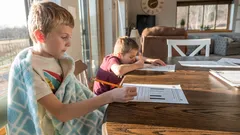224
8
4 minutes
Suggested Articles

First-generation Ivy Leaguers triumph over unique college challenges
Discover key insights, life hacks, and data-driven tips for first-generation college students thriving in prestigious U.S. universities. Find practical strategies, unique challenges, and fresh perspectives essential for student success.

Parents empower kids with smart routines to boost school and neighborhood safety
News & Updates

Cellphone bans in schools spark sharper focus and real student connection
News & Updates

Parents see children gain confidence and lifelong friends at today’s inclusive summer camps
Volunteer

Chicago schools transform special education with more support and smarter tools
News & Updates

How prison rehabilitation programs spark hope and second chances
Civic Education

Top Classroom Rules for High School That Foster Success
Civic Education

Federal funding delays threaten vital support for US students and schools
News & Updates

Homeschool parents embrace freedom as lawmakers spark a new regulation debate
News & Updates

Educators warn Head Start exclusion leaves undocumented children behind
Civic Education

Colorado schools unlock $80M in federal funding, fueling big gains for students
Hiring

First-generation Ivy Leaguers triumph over unique college challenges
Hiring

Americans brace for possible Social Security cuts that reshape retirement
News & Updates

Why this Florida data leak changes how we think about privacy
News & Updates

Build your own AI chatbot and unlock hands-on tech superpowers
Resources & Tools

How to outsmart hidden medical expenses in your golden years
Civic Education

California workers secure jobs this summer with new 2025 laws
Hiring
 Love Women Vibes
Love Women Vibes

Comments